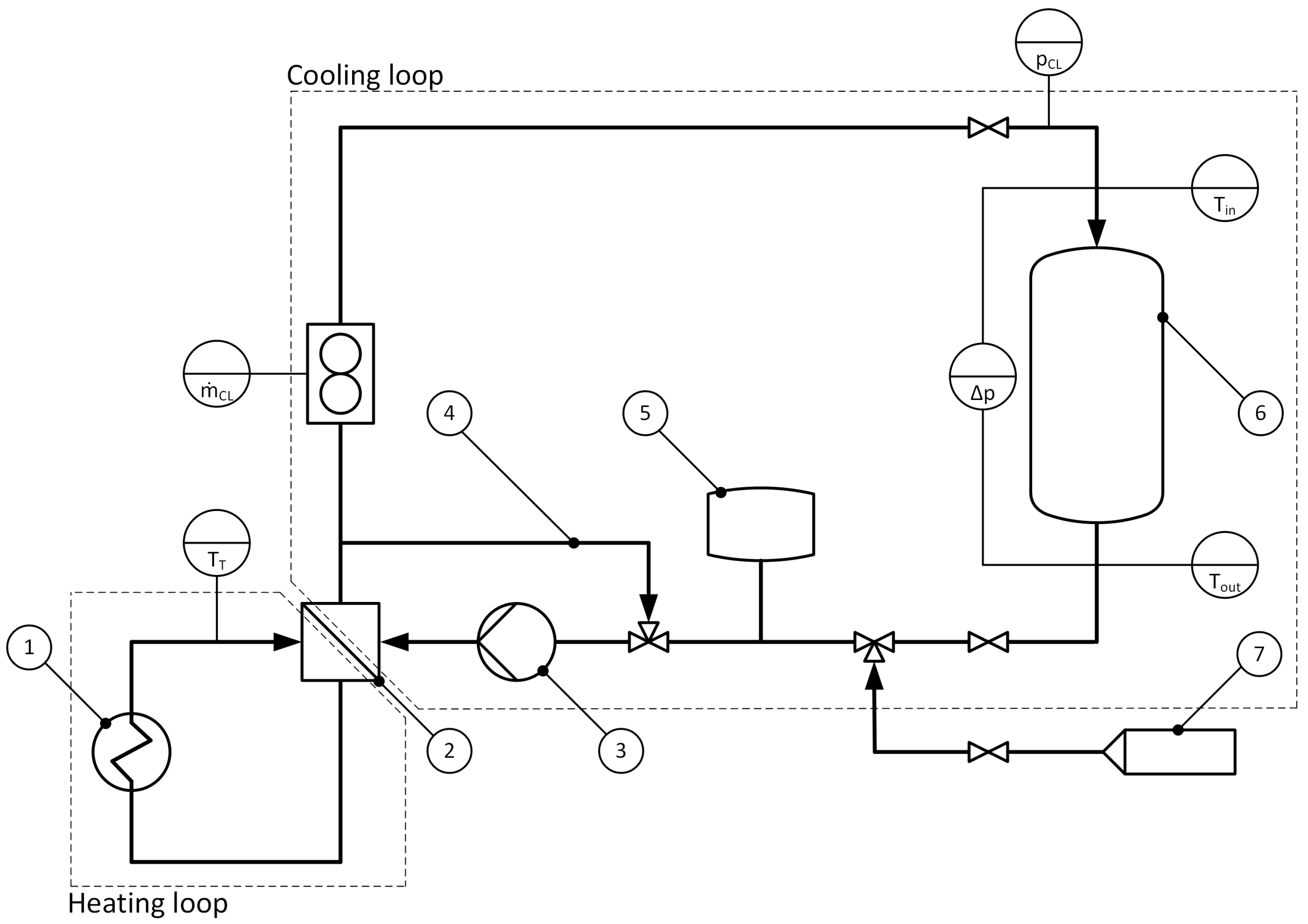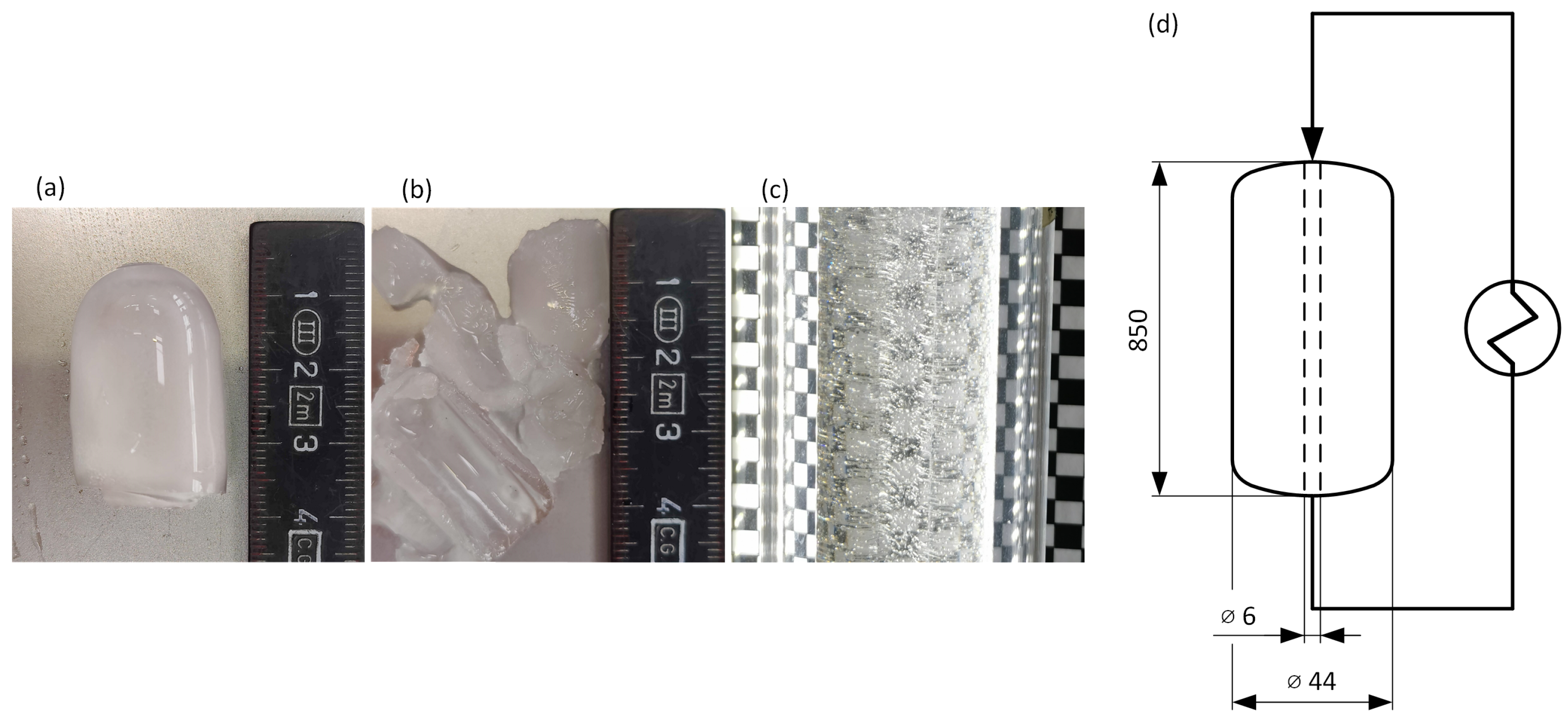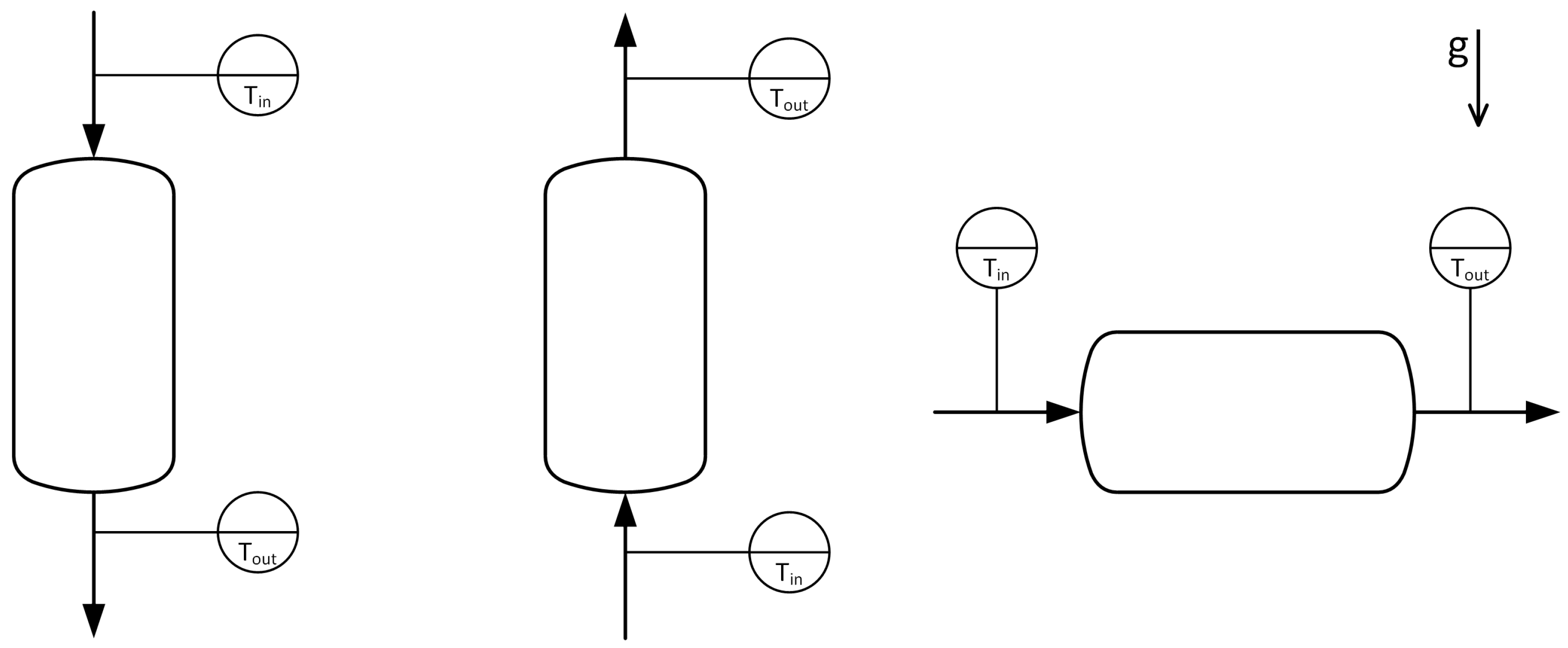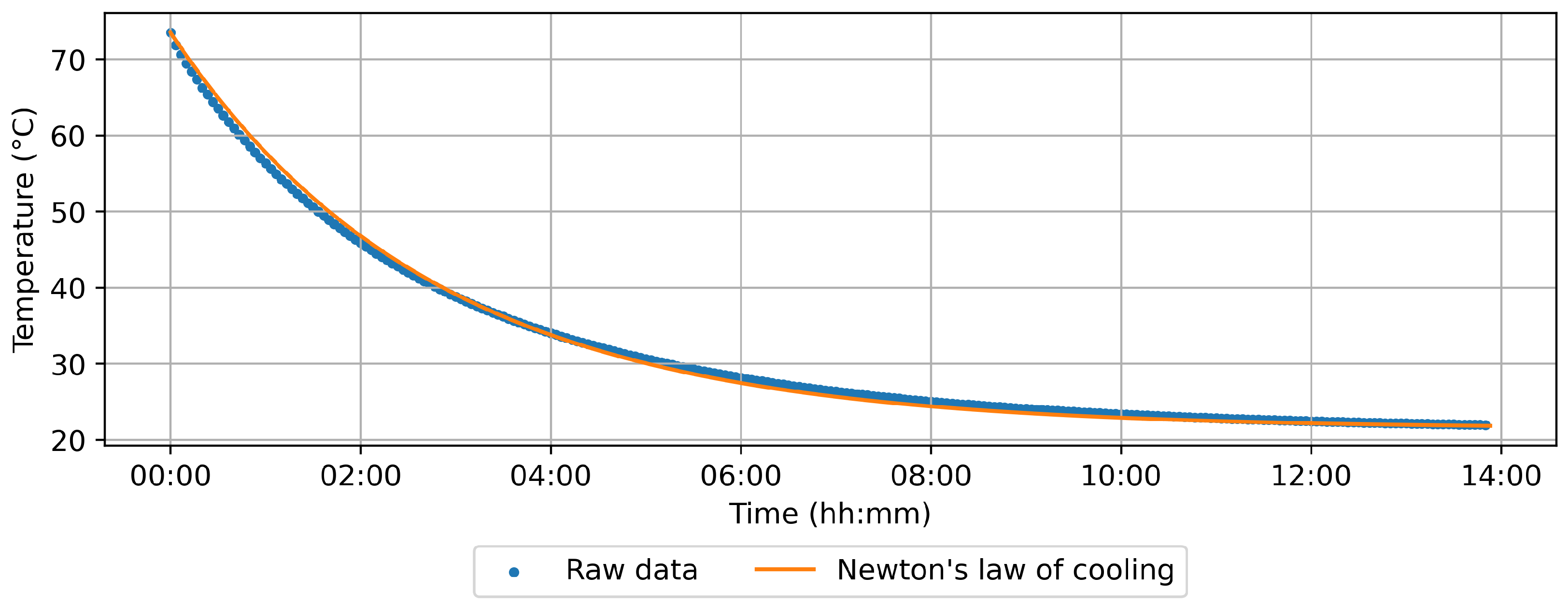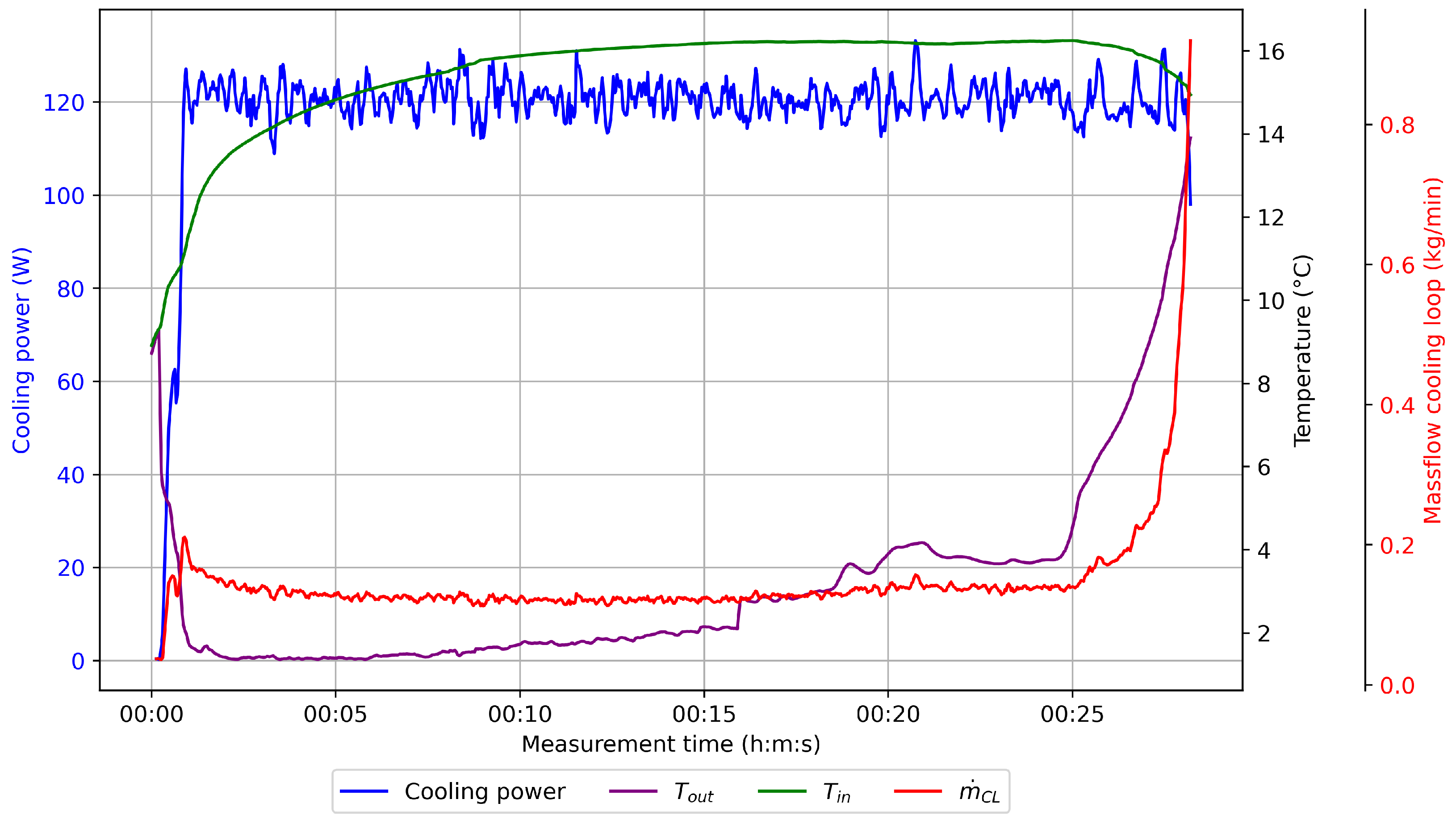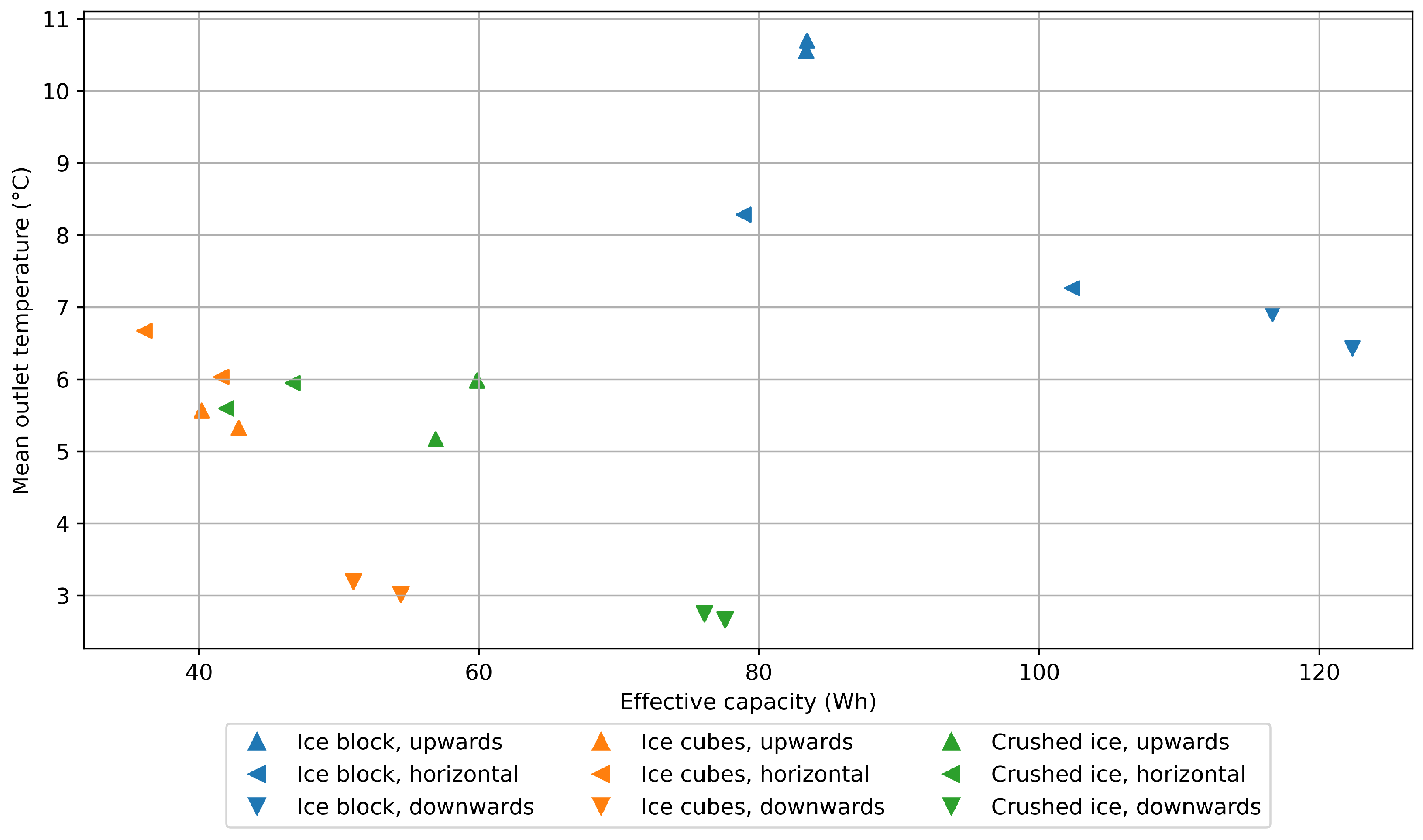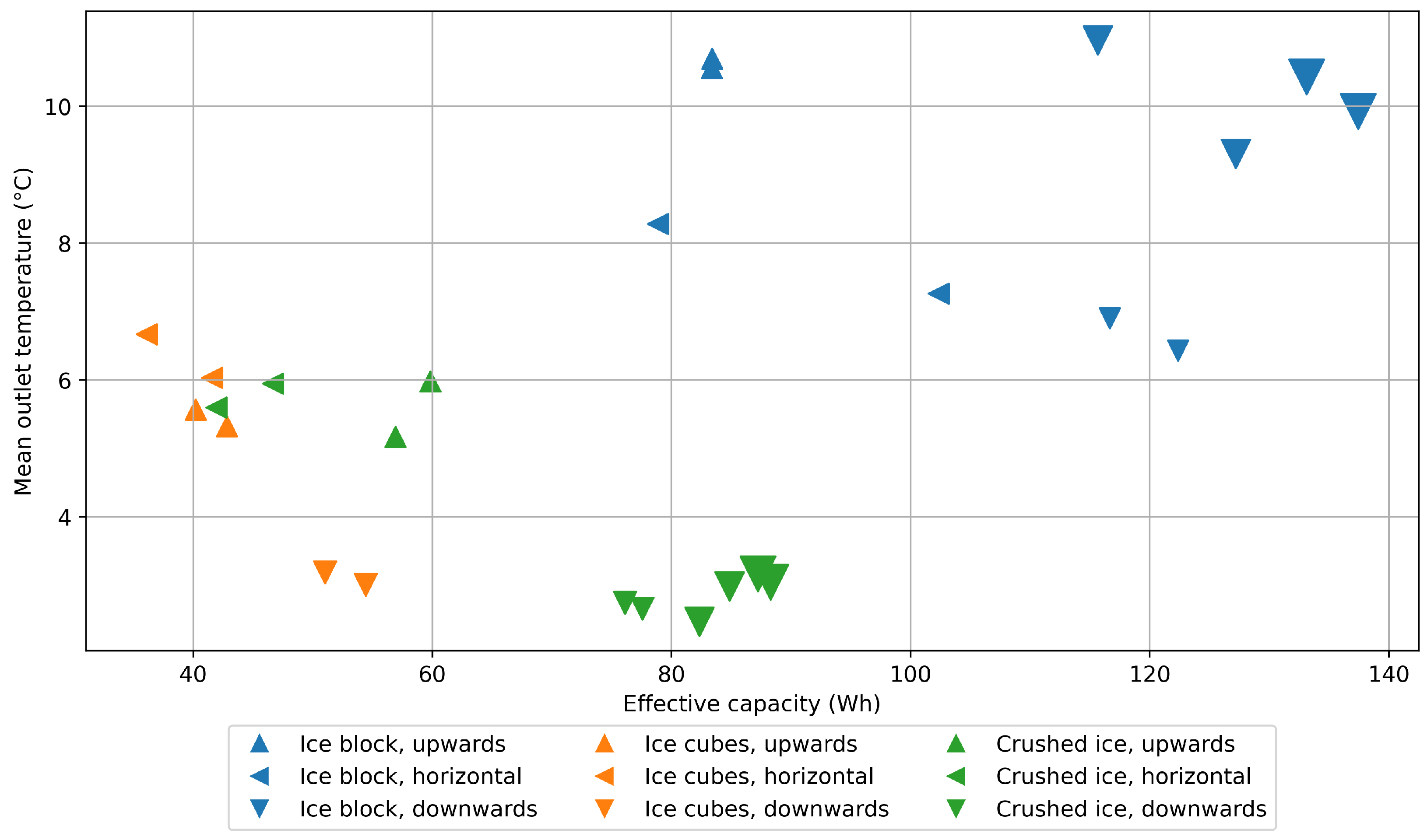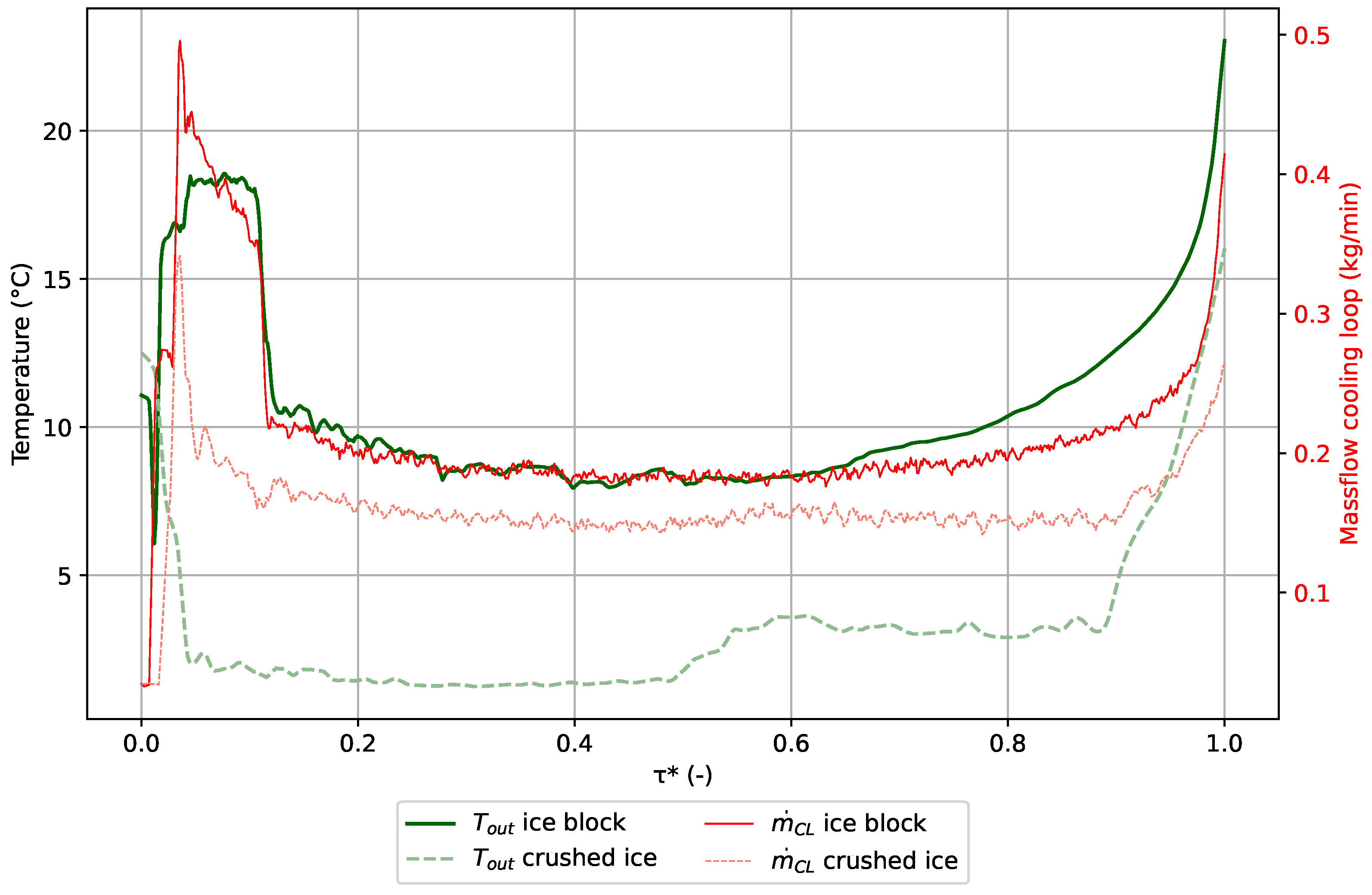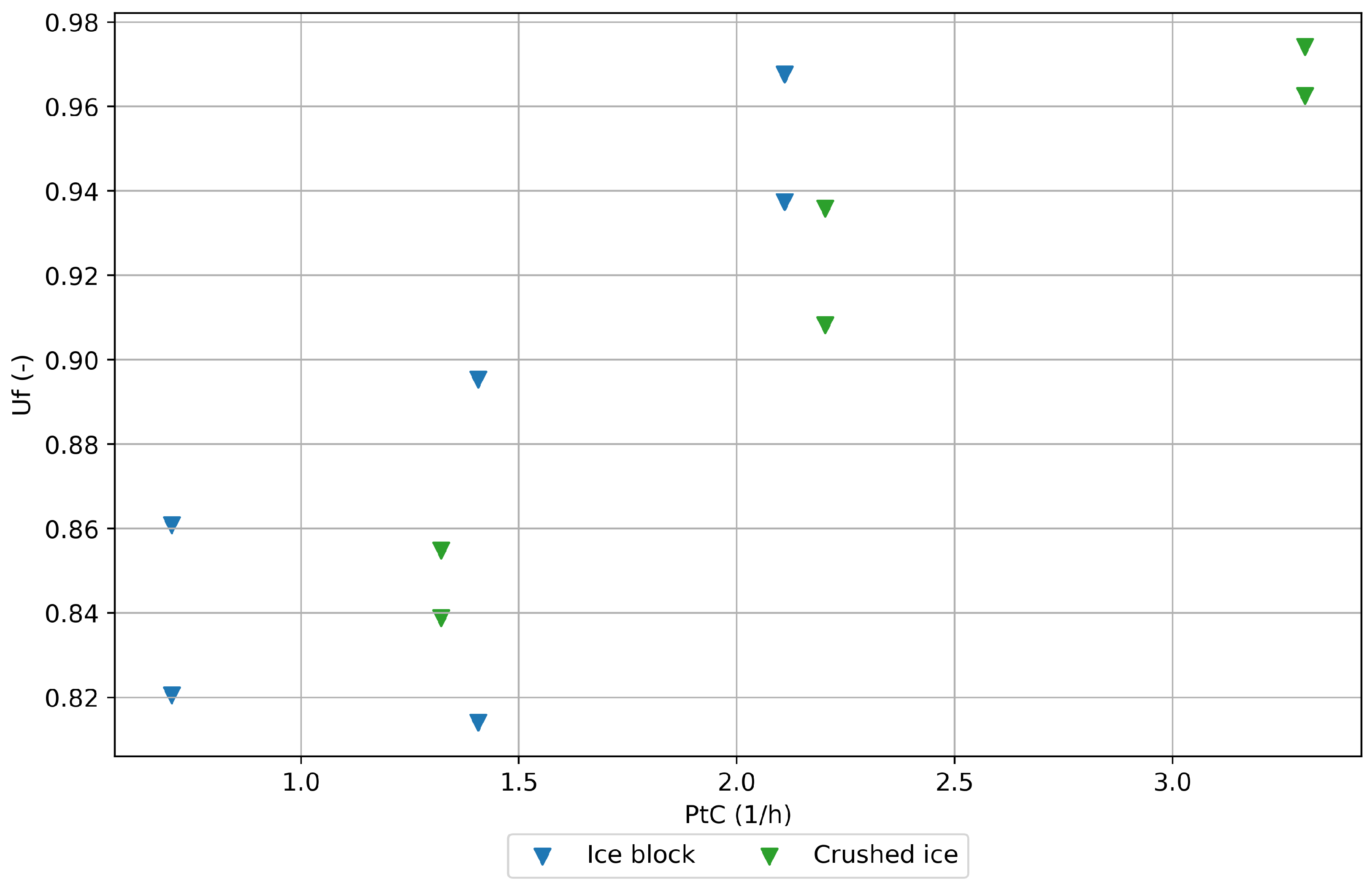1. Introduction
Hyperloop transport operates in a vacuum-like tube environment, which makes a thermal management system (TMS) indispensable for handling waste heat from components. Passive cooling (e.g., by ambient air) is only possible to a very limited extent in such environments. Hyperloop envisions high-speed transportation within low-pressure tubes that drastically reduce aerodynamic drag. Within these tubes, transport pods are propelled by a linear electric motor and levitated using electromagnetic suspension. The foundational principles of Hyperloop—such as maglev propulsion and operation in low-pressure tunnels—have antecedents in earlier concepts like Swissmetro, a 1970s proposal for high-speed magnetic-levitation transport in underground partial-vacuum tubes developed by EPFL and ETH Zurich [
1]. In the Hyperloop pod, components like the linear motor, power electronics, and batteries will generate substantial heat that must be managed in a thin-air environment. According to the Delft Hyperloop study [
2], there are three principal approaches for active cooling in a Hyperloop pod: radiation, sublimation of ice, and latent heat storage (LHS). Delft Hyperloop shows that the use of LHS is the most promising solution for a TMS in a Hyperloop. Radiation is only marginally possible because of the small temperature gradient. Sublimation, on the other hand, increases the necessary infrastructure, as it requires condensers upstream of the vacuum pumps. LHS systems utilize the ability of phase change materials (PCMs) to store/release large amounts of thermal energy during phase change (melting/crystallization) while maintaining a constant temperature. LHS systems achieve a high energy density (150–400 J/cm
3 and 150–350 J/g) [
3].
For an LHS system in a Hyperloop, the choice of PCM is critical. The PCM’s phase change temperature must be in a range that can absorb heat from the pod’s systems. The Hyperloop TMS must regulate the temperature of various components (e.g., motors, electronics) and also provide climate control for passengers. A comfortable cabin temperature around 20–23 °C is desired, so the PCM’s melting temperature should be below 20 °C to effectively absorb heat and keep the cabin and equipment cool. In practice, a PCM melting temperature in the range of about −5 °C to 20 °C is targeted to meet the cooling requirements of the Hyperloop pod’s systems [
2]. While the PCM sets the lower thermal boundary of the storage system, heat transfer to the components is managed by an HTF that remains warmer than the PCM’s melting point, ensuring that sub-zero cooling of sensitive components is avoided. Choosing a PCM with a lower melting temperature, such as −5 °C, supports a wider operating range and increases the usable sensible heat in the liquid state, as the PCM can be heated further before reaching its upper operating limit. This effectively improves the overall energy density of the system by maximizing the temperature span over which sensible heat can be stored and extracted. In addition, mass is also a critical constraint in Hyperloop design due to its influence on energy consumption and dynamic performance. In addition, mass is also a critical constraint in Hyperloop design due to its influence on energy consumption and dynamic performance. Therefore, the PCM must possess a high volumetric and gravimetric energy density to maximize thermal storage capacity while minimizing system weight.
Table 1 lists several PCM candidates within the desired temperature range, highlighting the advantage of water in terms of its notably high melting enthalpy.
Water has a melting point of 0 °C, which is within the desired range and a high melting enthalpy (333.7 J/g). In addition, liquid water has a high specific heat capacity (4.23 J/(g K)), significantly higher than the other PCMs listed (
Table 1). These properties mean that water can provide the highest energy density in the relevant temperature range. The high energy density allows for more thermal energy to be stored per unit mass, which directly contributes to reducing the overall weight of the TMS.
In addition to high energy density, the TMS must also ensure a flexible and responsive thermal power output to match varying heat loads from the Hyperloop pod’s systems. According to the feasibility study of Delft Hyperloop, these heat quantities range from 6 kW to 30 MW for a full-sized system [
2]. However, a common limitation of LHS is the low heat transfer during the solid state of the PCM due to the change between the dominated heat transfer by convection in the liquid state and by conduction in the solid state. The conventional approach to address this limitation involves the use of heat exchanger (HEX) structure to increase the heat transfer surface [
5]. While effective, these solutions introduce additional mass—counterproductive in a system where weight minimization is critical. To overcome this, two alternative strategies can be considered: the development of advanced PCMs with intrinsically higher thermal conductivity or the use of the storage in direct contact, which increases the heat transfer surface without adding additional mass [
6]. The latter approach of a direct contact latent heat storage (DCLHS) promises a pathway for enhancing PCM integration in compact, high-performance thermal management systems. In a DCLHS, the heat transfer fluid (HTF) is injected directly with a nozzle into a tank filled with PCM. This direct injection generates numerous small droplets and this results in a large contact surface between the two immiscible media. The large contact surface creates ideal conditions for efficient heat transfer [
5]. Owing to the difference in density between the PCM and the HTF, the HTF flows separately through the tank. This creates a complex channel network that acts as a direct contact HEX. As the PCM takes up to 90% of the storage volume, which leads to high energy densities while still allowing the system to be built compactly and simply. Despite the advantages a DCLHS offers, it has not yet been sufficiently researched compared to conventional LHS systems [
5,
7]. Thus far, only small DCLHS systems have been built for certain PCM/HTF combinations, namely salt hydrates/oil [
8], paraffin/water solutions [
9], ester/water [
6], erythritol/oil [
10] and ice/thermal oil [
4]. These studies show a clear potential of the system to achieve a high heat transfer rate and high energy density at a system level. Nevertheless, several challenges were identified that do not allow a robust operation of a DCLHS without further improvement. Two major challenge are the emulsification of HTF and PCM and the carry-over of PCM from the storage tank into the HTF cycle, which can cause blockages in the piping system or can damage equipment when the PCM solidifies [
6,
11]. This problem is exacerbated by higher HTF mass flow rates, which are required to achieve higher power outputs.
In this study, water is employed as both the PCM and the HTF—with liquid water acting as the HTF and solid ice as the PCM. This unique choice eliminates the risk of emulsification and phase separation, since both phases are the same substance. However, the solidification of the storage material has to occur in a separate process as the HTF would also freeze during this operation. In the context of Hyperloop operation, this constraint can be addressed by implementing a system architecture in which the thermal energy storage is fully discharged during transit, followed by either replacement of the storage module or in-situ refilling at terminal stations. This approach allows the recharging (solidification) process to occur independently under controlled conditions at the station, ensuring that the PCM is fully regenerated prior to the next operational cycle. In conventional outdoor transport systems operating in cold climates, freezing of the HTF would typically be a concern. However, this issue is mitigated in Hyperloop applications, as the thermal management system is installed inside the transport pod, which is thermally insulated from the external environment by the surrounding vacuum tube. As a result, the interior remains at a controlled temperature above freezing, making water a practical and justified choice for use in the system. This work focuses on the experimental DCLHS system using ice and water, targeting the specific thermal management demands of a Hyperloop transport system. The goal is to achieve high energy density and rapid thermal response to support peak cooling loads during operation. A critical factor influencing these outcomes is the shape of the ice used in the storage unit. Different ice shapes, such as crushed ice, ice cubes, or a large ice block, affect both the heat transfer rate and the effective utilization of the PCM. Smaller ice particles provide higher surface area for heat exchange, leading to faster thermal response, while larger blocks offer greater volumetric storage efficiency. We hypothesize that ice shape significantly impacts the outlet fluid temperature profile and the total amount of energy extracted. Understanding the relationship between ice shape and system performance offers valuable insights into the internal flow dynamics and thermal interactions within the DCLHS. While the proposed cooling system can certainly be adapted for other applications, its combination of low weight, compact design, and high energy density makes it particularly well-suited for the stringent requirements of Hyperloop systems.
4. Discussion
Based on the previously presented results, this discussion section examines the power and capacity of the CCS, as well as the thermal characteristics of its outlet temperature.
4.1. Power and Capacity
The results from the previous experiments clearly demonstrate that the ice cubes configuration yielded the lowest effective capacity, which aligns with expectations due to its lower packing density.
When isolating the influence of flow direction, independent of ice shapes, it was found to have a dominant impact on capacity. The horizontal flow configuration exhibited the largest variability in capacity within a single flow direction. This inconsistency is primarily attributed to buoyancy-driven effects: during the initial stages of operation, ice tends to accumulate at the top of the storage unit while water flows beneath it, reducing effective thermal contact and stratification. Additionally, uncertainties in experimental preparation—such as the variation in freezing time and handling of the ice block contributed to capacity fluctuations in all three flow directions. In contrast, the preparation and loading of ice cubes and crushed ice were more reproducible, leading to improved consistency across experiments.
Among all tested flow directions, the
downward configuration consistently resulted in the highest effective capacities across all ice shapes. This enhancement is attributed to favorable thermal stratification, enabled by the anomalous density behavior of water, which reaches a maximum at 4 °C [
15]. Cooler water sinks to the bottom of the CCS, promoting efficient layering and heat transfer. Such stratification cannot form in
horizontal or
upward configurations, negatively impacting performance in those cases.
From a thermal regulation perspective, crushed ice provided more stable outlet temperatures. The formation of random flow channels facilitated uniform heat exchange and allowed for more controlled cooling power delivery. In contrast, the ice block offered a lower surface area-to-volume ratio, limiting heat transfer. Although the contact area between water and ice gradually increased during melting, it remained substantially lower than that of crushed ice. Consequently, the ice block exhibited higher outlet temperatures and required increased mass flow rates to maintain the same cooling power. In downward flow conditions, the accumulation of a liquid water layer beneath the ice block acted as a thermal buffer, stabilizing outlet temperatures and contributing to smoother power regulation.
A positive correlation between the power-to-capacity ratio and the utilization factor was observed. This trend is partially explained by thermal losses from the CCS, which were not included in the calculation of effective capacities. The estimated heat loss of the CCS is 12.0 W (see Equation (
9)). Since experiments with higher nominal cooling power and therefore higher
typically had shorter durations, they incurred lower total heat losses, resulting in relatively higher
values.
It should be noted that this heat loss estimate accounts only for surface losses of the storage tank. Additional losses in the circulation system—such as from piping, valves, and the pump—were not included and would further reduce the actual delivered cooling energy. As a result, if thermal losses were not accounted for, the reported effective capacities would slightly overstate the actual energy delivered by the CCS. However, since such losses would also occur in a real application, their presence does not compromise the validity of the comparison. Moreover, all configurations were tested under comparable ambient conditions and durations, ensuring that the relative differences between them remain meaningful and consistent.
Both crushed ice and ice block configurations achieved similar utilisation factors, indicating that a comparable proportion of their respective theoretical capacities was extracted. However, it is important to note that this comparison is based on the individual theoretical capacities of each shape. If the comparison were instead made using a common maximum theoretical capacity (e.g., that of the ice block), the crushed ice would yield a lower due to its inherently lower packing density.
4.2. Outlet Temperature
Across all experiments, the
downward flow direction consistently produced the most stable outlet temperatures and exhibited the least variability between repeated runs. This effect can be attributed to the anomalous density behavior of water, which facilitates the formation of a thermally stratified layer. Due to the density differences between ice and liquid water, the ice naturally accumulates at the top of the CCS, while water near 4 °C—the temperature at which water reaches its maximum density—settles at the bottom of the tank [
15]. This stratification effect contributes to the stabilization of outlet temperatures, particularly evident in the
crushed ice configuration, where a plateau around 4 °C is observed in the second half of the discharge cycle. The
crushed ice configuration inherently provides a larger surface area for heat exchange compared to the
ice block, which enhances thermal responsiveness and enables more effective regulation of the outlet temperature under varying cooling power conditions. In the
downward flow configuration, the outlet temperature of the CCS using
crushed ice remained largely unaffected by changes in set cooling power, further demonstrating its thermal robustness. The CCS with
crushed ice reached a steady-state outlet temperature in less than 5% of the total measurement time, while the system with an
ice block required more than 20% of the duration to stabilize. This indicates that
ice blocks respond more slowly to changes in thermal load—a potentially critical limitation in applications with rapidly fluctuating cooling demands, such as in a Hyperloop environment. For actual TMS in a Hyperloop, implementing a mass flow regulation strategy would be a suitable approach to actively control outlet temperatures and adapt to varying cooling demands in real time.
5. Conclusions
In this study, a laboratory-scale CCS was experimentally investigated and characterized with respect to flow direction and ice shape to gain an initial understanding of which configurations may be most suitable for implementation in a TMS for a potential Hyperloop application. Among the tested parameters, flow direction was identified as a dominant factor influencing system performance. The downward flow direction consistently yielded the lowest outlet temperatures and the highest effective capacities across all ice shapes. These findings suggest that the downward configuration promotes favourable thermal stratification within the CCS, enhancing overall heat transfer efficiency.
In particular, the combination of downward flow with crushed ice proved highly effective. This configuration maintained a low and stable mean outlet temperature of approximately 3 °C, even under varying nominal cooling powers. Such thermal stability under different load conditions is advantageous for TMS applications where dynamic cooling demands are expected.
While the ice block configuration offered a higher effective capacity due to its high packing density of 98%, it was less responsive to changing thermal loads. The outlet temperature in ice block experiments exhibited a stronger dependence on the set cooling power and showed delayed stabilization. These characteristics suggest a slower dynamic response, which could be a limitation in systems requiring rapid thermal adjustment. As a result, crushed ice in the downward flow direction is identified as the most favourable configuration for applications requiring both high thermal responsiveness and consistent outlet temperature, reaching steady-state conditions approximately five times faster than the ice block configuration. However, due to its lower packing density of 56%, crushed ice offers less overall cooling capacity compared to the ice block, which provides greater thermal storage potential but responds more slowly to temperature changes. Therefore, an optimal balance between the fast thermal response of crushed ice and the higher cooling capacity of the ice block must be found to meet both dynamic and sustained cooling demands effectively.
To build upon these findings, future research should aim to optimize the properties of ice-based cooling media to close the performance gap between crushed ice and ice block. This includes identifying an intermediate particle size and volume distribution that improves packing density and overall energy storage capacity, while still maintaining the fast thermal response observed with crushed ice. Additionally, improved flow distribution strategies should be explored to enhance stratification and promote uniform heat transfer within the CCS.
Further investigations into long-term cycling stability, melting dynamics under realistic TMS load profiles and the scaling of system volume are recommended. Expanding the storage volume of the experimental setup may help mitigate boundary effects, which could have influenced the thermal performance measurements and system behavior in this study. Additionally, the random size distribution of the crushed ice may have affected the results; therefore, future tests should also consider using ice samples with more uniform and defined shapes to better isolate and understand shape-related performance differences.
When scaling up the CCS for implementation, boundary conditions, surface-to-volume ratios, and other real-world effects—such as mechanical vibrations—will differ from the controlled laboratory setup. These factors can influence melting dynamics, thermal stratification, and overall system behavior. While the modular design of the CCS supports scalable adaptation, further investigations are needed to understand how these geometric and physical influences affect performance on larger scales.
